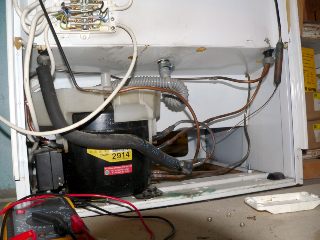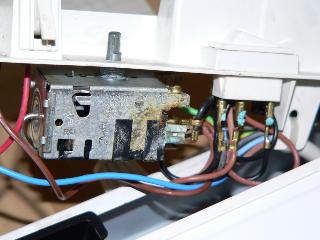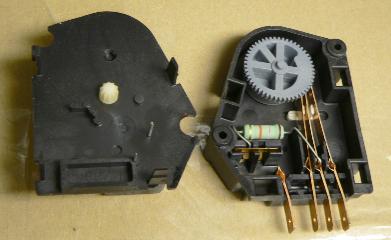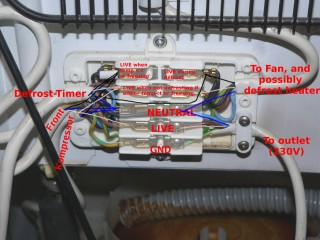A quick look in our freezer:
My parents have an old freezer, a Cylinda with no model marking (only says "Cylinda NO FROST" on the panel). It's been working great most of the time, except a period when it used to stop working in its defrosting cycle. We solved that problem by putting a thermometer in the kitchen showing the temperature of he freezer down in the basement. Since the thermometer was installed, we had no problems at all with the freezer quitting on us...
One autumn, we experienced a completely new problem with it. It started leaking water, and in the bottom of the freezer, a large chunk of ice was forming. I would estimate the ice to around 10 litres in total. The freezer was supposed to be automatically defrosting, but that obviously had failed. One brother of mine started defrosting it while it was running, as it was only the bottom that needed defrosting. I for one would have waited for colder weather, so we could have emptied it before starting. BTW, if the freezer is in a basement, and it won't hurt to get a lot of water on the floor, one can try defrosting it by slowly hosing the ice with cold water. Better then anything else I've ever tried.
Anyway, after the defrosting, the freezer refused to get colder then -7 degrees C. It was actually swinging between -5 and -7 for several days. My father "untied my hands" and gave me a go at it. I actually knew very little about fridges, so I did the peeking and poking around to find out how it worked. I started out with some false assumptions, which might be useful for others. But first a description of every interesting part of the fridge.
Outside:
Seems to be a usual full-height white Cylinda freezer, around 15 years old, nothing fancy.
Inside:
Shelves with flip-down fronts in the top, and drawers in the bottom of the fridge.
Cooling element:
There are no visible cooling elements, they are all hidden behind the back wall. There is a fan (also behind that wall) which sucks air from the bottom of the fridge, through the cooling elements, and blows the cold air into the top of the fridge.
Compressor:
 A Dannfors compressor which I couldn't find any data sheets on. Its model number is 2914. It's an oil-cooled compressor, and the warm oil seems to be circulated somewhere inside the fridge. My uneducated guess would be that the hot oil makes sure that the fan in the freezer won't get covered with ice.
A Dannfors compressor which I couldn't find any data sheets on. Its model number is 2914. It's an oil-cooled compressor, and the warm oil seems to be circulated somewhere inside the fridge. My uneducated guess would be that the hot oil makes sure that the fan in the freezer won't get covered with ice.
Thermostat:
 The thermostat is of the mechanical type, and has some kind of capillary (compare with a heat pipe) from the inside of the freezer connected. It seemes like a lot of condensation was forming inside the plastic housing covering all the electronics in the top panel, and you can see that some kind of electrolysis has been going on in there.
The thermostat is of the mechanical type, and has some kind of capillary (compare with a heat pipe) from the inside of the freezer connected. It seemes like a lot of condensation was forming inside the plastic housing covering all the electronics in the top panel, and you can see that some kind of electrolysis has been going on in there.
Defrosting module:
 The defrosting is done by a synchronous-driven box which turns of the freezer every 8'th hour, and turns on some kind of electric heating, probably wound around the freezing elements inside. It's this module which had failed previously, and we got the tip that you often can get it working again by just rotating the knob one step ahead (if the engine had stalled)
The defrosting is done by a synchronous-driven box which turns of the freezer every 8'th hour, and turns on some kind of electric heating, probably wound around the freezing elements inside. It's this module which had failed previously, and we got the tip that you often can get it working again by just rotating the knob one step ahead (if the engine had stalled)
Electric wiring:
 This is more or less what I think it looked like. Note that it's the best of my recollection, and that Cylinda might change colours and locations between models, or even during models. Click on the image to enlarge.
This is more or less what I think it looked like. Note that it's the best of my recollection, and that Cylinda might change colours and locations between models, or even during models. Click on the image to enlarge.
False assumption: Stuck defrosting valve
My father had made comments about the freezer making strange sounds when the compressor was running, and I found some article about that and freezers. It appears like some freezers have an electrically controlled valve inside, which diverts the flow of the cooling agent such that parts inside the freezer gets heated (and hence defrosted). If that valve would get (partially) stuck, you could get a freezer with little or no cooling capacity. The hot oil pipes from the compressor fooled me into thinking that it might be a valve failure for a while, before I was convinced that the freezer had electronic defrosting.
False assumption 2: defrosting module
Next, I thought that the defrosting module might be faulty in the sense that it activated the defrosting to often/to long, or something like that. I actually wired the freezer to run without the defroster unit for a day or two, but there was no change in temperature.
Final solution at last:
I had read a little about the insulating power of ice, and just learnt that a few mm could make the cooling ten-twenty times less efficient. I decided to try defrosting the freezer twice in a row, by turning the dial on the defrosting module to force the freezer to defrost, and then repeating that as soon as the defrosting ended. It was interesting, because I could hear large chunks of ice sliding down in the inside of the fridge during the second defrost. And after that procedure, the temperature of the freezer started to drop rapidly. I repeated it a second time a day later just for extra safety.
I guess that when the freezer was on during the defrosting, a huge chunk of ice was formed inside it (hidden behind the wall). I would also guess that the ordinary defrost wasn't enough to melt that block of ice, and had no or little effect at all. We actually had the same "running water" problem a couple of months later, and the same double defrost procedure solved it again. Maybe it's time to completely replace that module now.
